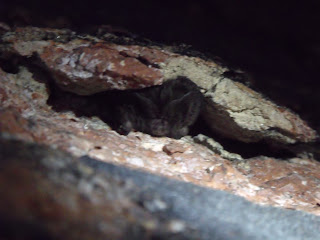Yesterday, A small number of the BBG and a colleague were doing a badger training day, we were in Kings Wood (Houghton Conquest) and we happened apon an oak tree with a hole in it.
Polly had her endoscope on her so we had a look, where were a minimum of two brown long eared bats and a possible third in the cavity.
Martin

The Bedfordshire Bat Group was formed in 1988 and is affiliated to the Bedfordshire Natural History Society and a partner group of the national organisation, The Bat Conservation Trust. The bat group works for bat conservation within Bedfordshire and Luton;carries out surveys of bats and maintains a database of bat records; works with people to provide information and raise awareness of bat conservation; and, when necessary, carries out bat care and rehabilitation
Search from here
Sunday, 26 February 2012
Sunday, 19 February 2012
Dawn Swarming
The roost consists at its peak in excess of 1500 bats, being a maternity roost. It has been monitored for several years now and numbers have been growing year on year. The main concern was that the space they use to roost would be to small for much more expansion, however several licenced members gained access into the roost over winter and it would seem that there is still plenty of space for growth yet.
The above clip is a snap shot of the dawn swarming process, which can last for up to and beyond an hour, this is were lots of bats fly around the entrances to their roosts (swarm) before entering the roost for the day. There are two types of swarming the dawn as above and autumn swarming which is quite different.
Autumn swarming is a prolonged process happening over several hours and late into the night, involving far fewer bats. It occurs at hibernation sites, and several thoeries have been suggested as to why bats do this.
One of these is that the mothers are showing that years young the hibernation sites, another is that its has something to do with mating ensuring that genetic diversity is maintained in a population. Most bat groups are now undertaking work at autumn swarming sites to learn more about this behaviour.
Martin
Third Hibernation Survey
On the weekend of the 11th February the group undertook their final hibernation check of the winter. As it turns out the totals for this February was a record count with 125 bats across all the sites. The two pictures above show two of the species which were found.
These were taken by myself (Martin O'Connor) the top one is a barbastelle Barbastellus barbastella one of 10 located in the largest of the hibernation sites, with the bottom one being a brown long eared bat Plecotus auritus.
On the Sunday a rather cold looking BLEB was found in another site, see below:
You can see the frost on the bat above, does make you wonder if the bat has survived.
Monday, 6 February 2012
Hibernating Lesser
Myself and the better half went to Cheddar for the weekend, whilst wondering around the caves we came across this little fellow.
There were about 6 lesser horseshoes Rhinolophus hipposideros in the two caves we went into.There were almost certainly more bats in there but with the number of crevices and large chimneys in the roof of the cave we were lucky to see the ones we did.
There were about 6 lesser horseshoes Rhinolophus hipposideros in the two caves we went into.There were almost certainly more bats in there but with the number of crevices and large chimneys in the roof of the cave we were lucky to see the ones we did.
Subscribe to:
Comments (Atom)



